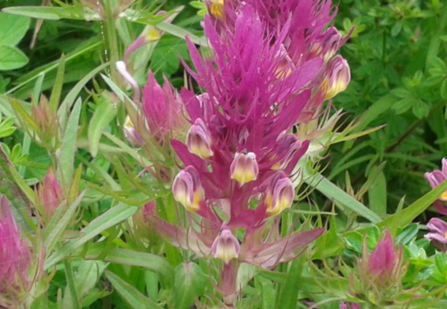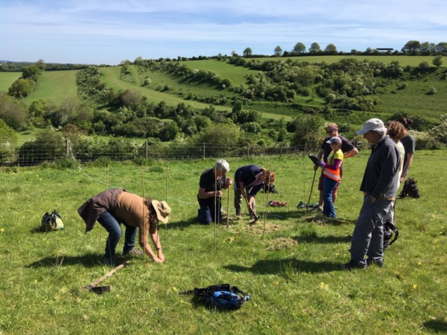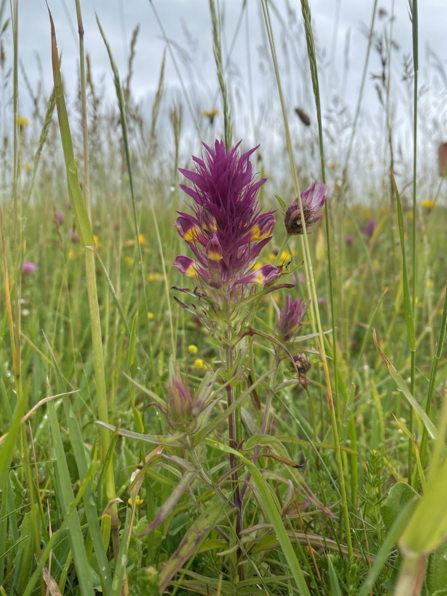This endangered species which was once widespread in arable fields can be found in just four sites in the South East and at a single site in Wiltshire; field cow-wheat could easily be lost in this county entirely. Dominic Price from The Species Recovery Trust is working with project staff and volunteers to establish this rare plant at Coombe Bissett Down nature reserve.
Introducing a rare plant (an experiment)
The history
Field cow-wheat is a fascinating plant with an interesting history. It is psychedelic in appearance with its head of vivid yellow and purple flowers. If you stumbled upon it on a walk, you could easily be mistaken for believing the ground had been littered with small pieces of brightly coloured plastic!
This now rare plant was once prolific in arable fields and was considered a weed known colloquially as ‘poverty weed’; people were paid to carefully pull up and carry the plant off site to be burnt, seeds and all. Its numbers were eventually decimated by modern agricultural practices. Its unpopularity owed to the way in which it would inadvertently make its way into wheat harvests, and when ground along with it, would dye the entire batch of flour a bright blue colour, thus rendering the flour useless for sale.

Field cow wheat - Steve Read
The discovery
The only remaining site for the species in Wiltshire now lies in a private garden, where it jumped into when its original home was built upon. This has not provided a great conservation outlook for the species, so Dominic approached the Trust about the possibility of introducing the species at one of our nature reserves. Using seed collected from all the UK sites (and some from the Millenium Seedbank at Kew Gardens), we are now in the early stages of developing a population of this colourful herbaceous plant at Coombe Bissett Down. So, why choose this particular nature reserve? Well, the little field cow-wheat that can be observed is usually found in open grassland with dry chalky soils; Coombe Bissett Down’s species rich chalk grasslands seemed the ideal location to perform this experiment.
The method
Another interesting fact about field cow-wheat is that it is a hemiparasitic plant; it depends on other plants for food, as well as using its own leaves for photosynthesis. The plant will spend the first three months putting down its roots to invade the root systems of others plants (usually grasses) and then grow its leaves to obtain other nutrients from sunlight.
On a sunny day in May 2019 project volunteers joined Dominic and project staff on site to rotovate the ground in preparation for sowing the seeds later in the season. As little was known about the conditions and amount of existing vegetation that would be required for the plant to successfully establish, three plots with different levels of scarification of the soil were prepared.

Volunteers preparing the ground at Coombe Bissett Down - Melanie Evans
Each plot was divided into three one metre sections. The first had its thick sward scarified very lightly; the second section was scarified further, leaving approximately fifty percent of the vegetation remaining; and the third and final section was rotovated heavily, with a very small amount of vegetation remaining. This process was repeated another two times in different areas of the reserve to test other variables, such as the amount of sunlight and shelter the germinating seeds would receive, and to observe if these conditions might have some impact on the level of success obtained.
In July, Dominic harvested and sowed the seeds into the prepared plots. The seeds were cast directly over the surface of the soil, mimicking what would naturally occur. This was timed with a subsequent weather forecast of rain which was essential in ensuring that the seeds would be secured into small cracks and crevices in the ground. Next, we waited for the results.
The results
During the following three months we anticipated, and hoped, that the seeds would be busy casting their roots down into the soil to find and invade the root systems of grasses. We would need to wait patiently until the spring to observe any signs that the field cow-wheat was establishing.
In March 2020, Dominic and I visited the site and we were finally greeted by the long awaited field cow-wheat seedlings. In one plot we found more than forty seedlings! We waited again to observe signs that the seedlings would survive and blossom into colourful plants.
Then in June, Dominic and Reserves Manager (South), Ashley White, visited the plots to check on the progress of the seedlings. Plants were found in all three plots. In two of the plots, the plants appeared smaller, which may be due to their more exposed north and east facing locations. These particular plots were also unfenced and had been grazed by cattle. However the third and final plot, presented taller plants, some of which were in bloom. This plot had been fenced and is west facing which may provide a more sheltered aspect for the plants to develop. Safe to say, we were thrilled with the results and look forward to continuing to monitor the progress of this experiment establishing a rare plant.

Field cow wheat - Ashley White

